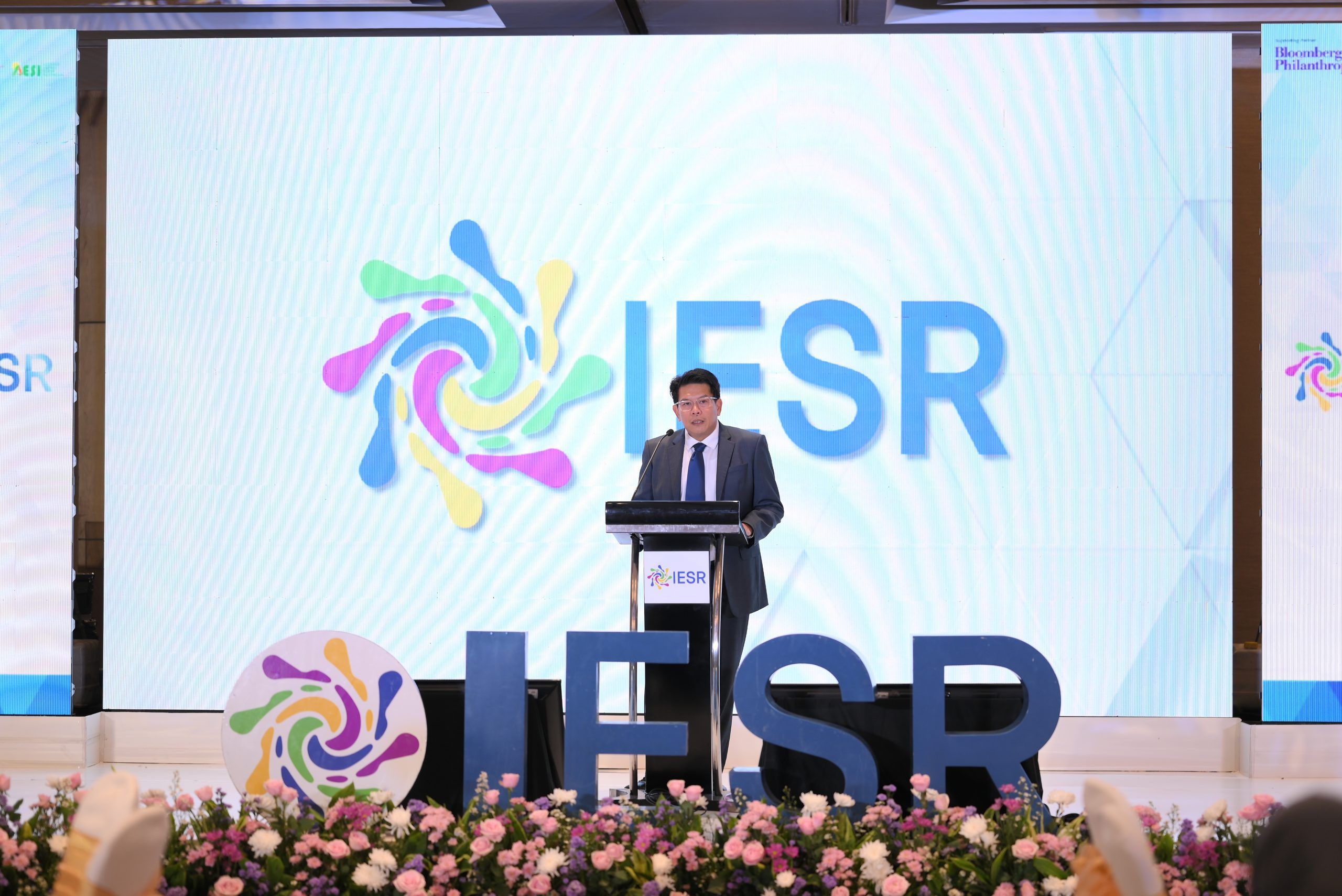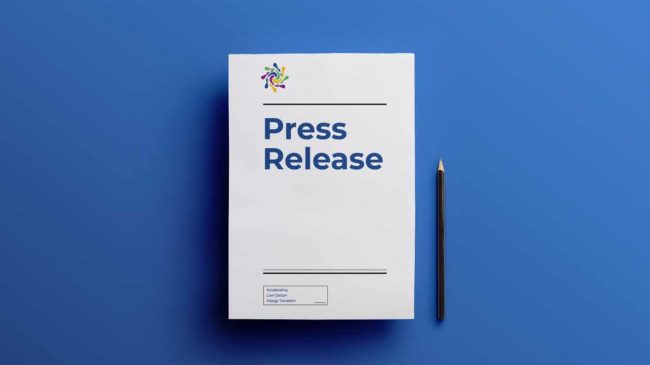
Fabby Tumiwa delivered his speech at the Shine Bright: Advancing G20 Solar Leadership event
Jakarta, 27 October 2022 – To achieve the target of a 23% renewable energy mix by 2025 and the energy system’s decarbonization by 2060 or earlier, Indonesia needs to seriously improve and implement policies that encourage the development of renewable energy, especially solar energy. The utilization of solar energy is believed to be fast and strategic to achieve these targets. Presenting the complete review of the development of solar energy throughout 2022 and providing a projection in 2023, the Institute for Essential Services Reform (IESR) published the flagship report, Indonesia Solar Energy Outlook (ISEO) 2023.
Arifin Tasrif, Minister of Energy and Mineral Resources of Indonesia on the event of Shine Bright: Advancing G20 Solar Leadership organized by IESR, said that based on IRENA data, the cost of electricity (Levelized cost of electricity/LCOE) has decreased significantly by 88% between 2010 and 2021, from USD 41.7/kWh to USD 4.7/kWh.
“But based on current practice in the industrial sector, we get offers of up to USD 3/kWh, including USD 4/kWh battery costs,” said Arifin at the Shine Bright: Advancing G20 Solar Leadership event organized by IESR with support from Bloomberg Philanthropies, and in collaboration with the International Solar Alliance, and the Indonesian Solar Energy Association.
Furthermore, he explained that based on the energy transition roadmap in Indonesia, solar energy plays an important role in electricity in Indonesia with 421 GW of 700 GW coming from solar.
“We need support from local producers and industries to fulfil local requirement content (LCR), considering that Indonesia has mineral potential and critical material for solar PV, battery, and electricity network, Besides, the aspect the easy access to cheap financing, incentive, and other financing facilities is very important to provide a financial feasibility study and increase renewable energy investment such as solar energy, “explained Arifin.
Fabby Tumiwa, Executive Director of IESR, said that in general, Indonesia made some progress since 2018, although it is relatively slow in encouraging the development of solar energy. According to him, some reforms are needed in regulations and their implementation, especially before the deadline for realizing the target, which is only three years left.
“Rooftop solar power plants that have the potential of 655 GW for building only, can be built quickly and involve community investment, without overburdening the government. Moreover, to expect additional renewable energy generation capacity from the implementation of PLN’s Business Plan (RUPTL) 2021-2030, rooftop solar power plants can meet a renewable energy mix target of 3 to 4 GW in 2025,” said Fabby.
Fabby added that the government and PLN need to allow permits for rooftop solar power plant installation.
“Availability of soft loan funds from financial institutions can support the adoption of household-scale PV mini-grid. Also, encouraging the adoption of solar PV in industrial areas, and non-PLN business areas needs to be done,” suggested Fabby.
ISEO 2023 stated that the progress of Indonesia’s solar energy can be seen from the decline in the price of solar electricity obtained through a power purchase agreement (PPA) made by PT PLN (Persero) with Independent Power Producers (IPP). Between 2015 and 2022, solar PPA prices declined by 78%, from $0.25/kWh to $0.056/kWh.
Furthermore, in terms of the project pipeline, there are currently eight projects that have been tendered totalling 585 MWp in capacity.
“In terms of utility-scale solar power plants, Indonesia has the potential for floating solar power plants. Its future development can make Indonesia a leader, and at the same time realize Indonesia’s leadership in terms of energy transition and use of solar energy in the G20 and ASEAN,” said Fabby.
Dr Ajay Mathur, Director General, of International Solar Alliance said solar energy is a potential energy source to be developed considering the increasingly competitive price of the technology.
“The International Solar Alliance (ISA) is proud to associate with the Institute for Essential Services Reform (IESR) to drive forward our common goal of making solar electricity the energy source of choice across the world. Solar Energy is the world’s most abundant and clean energy source, but also the global energy imperative to drive international climate action due to its fast-decreasing cost,” said Mathur.
At the same time, IESR and ISA signed a memorandum of understanding to accelerate the adoption of solar energy in Indonesia. ISA is an international institution that has various experiences and members from many countries. It has carried out innovations and facilitation to support solar energy development globally. The scope of the collaboration between ISA and IESR includes mapping the domestic solar industry, capacity building, and identifying financing schemes.
ISEO 2023 considers that the establishment of the ceiling price-based pricing in Presidential Regulation No. 112/2022 is expected to provide more space for developers to submit their bids. This regulation has been drafted since 2019 and initially considered feed-in-tariff instruments to encourage the development of renewable energy, especially small scale.
To encourage the effective implementation of PR 112/2022, a clear and transparent auction mechanism is needed, as a regular and planned auction schedule, as well as providing regulatory certainty and ease of licensing.
ISEO 2023 notes that local content requirements (LCR) are still one of the main obstacles in the auction of solar power plants in Indonesia. Based on Minister of Industry Regulation No. 5/2017, the minimum LCR value of goods for solar module components must reach at least 60% since 1 January 2019. However, the realization of the LCR of solar modules currently only reaches 47.5%. Moreover, the efficiency and price of domestic solar panels still do not meet the requirements of international financing bankability standards.
“The government needs to review the solar module LCR value provision policy based on industry readiness while preparing a long-term solar module industry policy to decarbonise Indonesia’s energy system,” said Daniel Kurniawan, Researcher, Photovoltaic Technology & Materials Specialist at IESR and Lead Author of ISEO 2023.
On the adoption of solar PV, although the Ministry of Energy and Mineral Resources has issued Ministerial Regulation No. 26/2021, some of its provisions have failed to be implemented, resulting in the slow growth of solar power plants. PLN’s oversupply of electricity is suspected to be the cause of the limitation of rooftop solar power plant (PVP) utilization to 10 to 15 per cent of capacity by PLN in early 2022. If it continues, it will be difficult to realize the solar targets that the government has set, such as the government’s 3.6 GW rooftop solar PSN target by 2025, and the 2.3 GWp solar project pipeline of 31 declarators at the Indonesia Solar Summit 2022.
“The government, in this case, the Ministry of Energy and Mineral Resources and PLN, needs to immediately provide a solution to this issue. Not to hinder adoption at a very early stage of adoption but to nurture the growth of rooftop solar until it reaches self-sufficiency. This can be achieved by providing a stable policy environment for market growth and development of the solar industry,” said Daniel.
The Indonesia Solar Energy Outlook (ISEO) 2023 report was first launched this year. Initially, the progress of solar energy development within the framework of the energy transition was integrated into the Indonesia Energy Transition Outlook (IETO) report.

